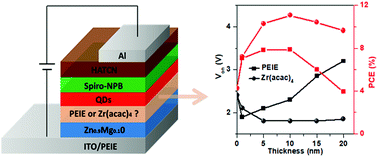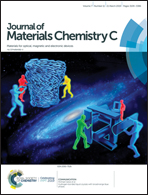Inverted quantum dot light-emitting diodes with conductive interlayers of zirconium acetylacetonate†
Abstract
In quantum-dot light-emitting diodes (QLEDs), exciton quenching at the interface of the quantum-dot emissive layer and the electron-transporting layer is one of the main non-radiative decay channels. One effective approach to suppress this interfacial exciton quenching is by using insulating interlayers. However, the use of insulating interlayers causes a dilemma because thicker interlayers, which are preferred for suppressing exciton quenching, can result in inefficient electron injection. Here, we demonstrate that the use of zirconium acetylacetonate (Zr(acac)4), a low work function and transparent metal chelate, as interlayers simultaneously suppresses interfacial exciton quenching and offers good electron-transporting properties. By employing an inverted QLED as a model system, we show that devices with Zr(acac)4 interlayers are superior to devices with insulating interlayers in a number of aspects, including higher optimal quantum efficiency, power efficiency, and longer operational lifetimes. Furthermore, the device performance is less sensitive to the thicknesses of the interlayers. Our study sheds light on the rational design of interlayers for high-performance QLEDs.



 Please wait while we load your content...
Please wait while we load your content...